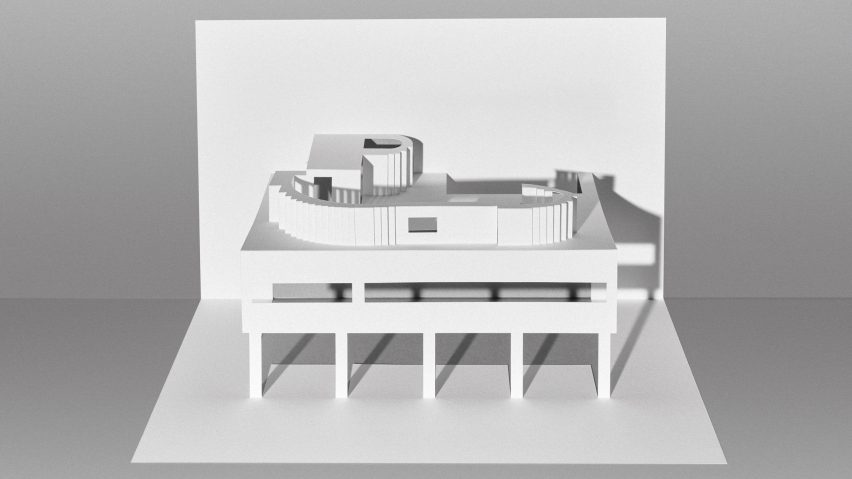Paper artist Marc Hagan-Guirey has recreated ten modernist buildings from folded and cut paper for his book Le Corbusier Paper Models: 10 Kirigami Buildings to Cut and Fold.
The book, which is released next month, contains step-by-step instructions and material to recreate 10 of Le Corbusier's most recognisable buildings in kirigami – a variation of the Japanese art of origami that involves cutting as well as folding the paper.
"Le Corbusier's work is perfect for recreating in kirigami," Hagan-Guirey told Dezeen.
"His buildings are monolithic and punctured with an assortment of seemingly random windows shapes. These distinctive silhouettes can be perfectly rendered in the simple shapes of kirigami," he continued.
"That's the aim with paper architecture – to make a simple arrangement of cuts and folds into instantly recognisable historic buildings. It also helps that curved surfaces are a rarity in Le Corb's work as they don't translate so well to paper."
The book is Hagan-Guirey's second that focuses on architecture, following Frank Lloyd Wright Paper Models which contains 14 kirigami designs to recreate the American architect's buildings.
This time he focused on the work of one of the pioneers of modern architecture, Swiss-French architect Le Corbusier, who Hagan-Guirey first came across while studying art in Manchester.
"I can remember coming across his work when I was writing an essay on futurism and architecture, and I discovered that aspects of Manchester's reformation after the second world war were influenced by his thinking," said Hagan-Guirey.
"On Oxford Road towards the university were areas with walkways above street level and the building had a section that straddled the busy traffic below – sadly that's not there anymore," he continued.
"I became a bit obsessed and it gave me a way for me to weave my love of science fiction into my art degree. With our cityscapes transforming at such a rapid pace, and often still based on his principles, I felt like now was a good time to put knife to paper in honour of his work."
The book contains some of the Swiss-French architect's best known buildings, including the Villa Savoye in Poissy, Maison de la Culture in Firminy and the High Court in Chandigarh.
These were all among the 17 Le Corbusier-designed buildings added to UNESCO's World Heritage List in 2016.
Alongside these buildings are the Maison Citrohan, Villa Stein-de Monzie, Maison de week-end, Maisons Jaoul, Unité d'habitation, Villa Sarabhai and Carpenter Center for the Visual Arts.
Hagan-Guirey picked the buildings that would be most suited to being recreated in paper form, while also trying to include some of the architectural highlights.
"Buildings that have many curves don't lend themselves so well to the modular aspect of kirigami, so that was certainly an influencing factor," he explained. "There are buildings such as Villa Savoye and Unite d'habitation that just had to go in."
Two notable omissions are the Chapelle Notre Dame du Haut at Ronchamp and the La Tourette monastery.
"Fondation Le Corbusier were very helpful and supportive but curiously they asked that no religious buildings should appear in the book," said Hagan-Guirey.
"Notre Dame du Haut, Ronchamp is probably one of the most famous of his works, but that would have been a bit of a nightmare to do justice in paper form. Ironically that was a bit of a blessing."
Of all the buildings in the book it is the lesser-known Villa Sarabhai in India, which is Hagan-Guirey's favourite.
"When you read about Le Corbusier you feel he had a bit of an ego," he said.
"However, when you see Villa Sarabhai and learn that this ultra serious architect designed a home with a toboggan slide leading from the top of the building down into a plunge pool, you can't help but smile at the inkling of irreverence."
Le Corbusier was one of the best-known architects of the 20th century and one of the key proponents of modernism.
Many of his buildings are now open to visit including his former apartment within the Immeuble Molitor, which reopened to the public in 2018, and the Pavilion Le Corbusier in Zurich, which was refurbished last year.

